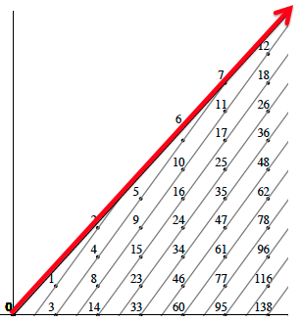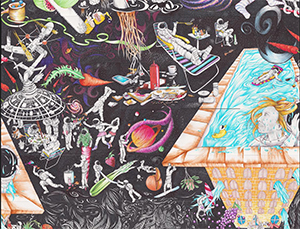
IRIS login | Reed College home Volume 96, No. 2: June 2017
Tags
"infinity"
How to Conquer the Number Plane

An ascending 1-stair packing polynomial, which assigns an integer to each co-ordinate in the sector of the plane that has been cordoned off by the hobgoblin's velvet cord (in this example, the hobgoblin chose the sector bounded by a line with slope 8/5).
Imagine dashing into a vast, Borgesian concert hall just before the curtain rises. There’s an infinite number of guests and an infinite number of seats, neatly arranged in rows and columns. Unfortunately, a mischievous hobgoblin has roped off a section of the auditorium with a velvet cord, putting some seats out of commission. How do you, Guest N, figure out where to sit?
Okay, it’s a far-fetched scenario, but math major Maddie Brandt ’15 is the first person in history to solve it in her paper “Quadratic Packing Polynomials On Sectors Of R2,” which she will present at a national conference in January.
The problem of assigning guests to seats is directly related to the problem of mapping the non-negative integers (those friendly, deceptively familiar objects such as 0,1,2,3, and their ilk) onto the co-ordinate plane (defined by pairs of integers such (0,0), (0,1), (0,2), etc.—think of the game of battleships). How do you map the integers to the co-ordinate pairs in such a way that you count all the pairs one after another, without skipping any?
Continue reading How to Conquer the Number Plane
Sketching Infinity
The universe of Vance Feldman ’05 explodes with jumbled houses, bridges and aqueducts, businessmen shaking hands, dolphins jumping out of rivers, and spacemen kicking their feet back in lawn chairs. To call his work monumental would be something of an understatement. Modestly titled the ForeverScape, his drawing rivals some of the longest art pieces in the world. Spanning roughly 650 feet from left to right—the equivalent of two football fields—the ForeverScape is assembled out of 700 sheets of letter-size paper and grows longer by the day.
The ForeverScape started in September, 2009, when Vance was in between jobs and found himself sitting in a bar with a ream of paper. He started aimlessly sketching a landscape and when the first page ended saw no reason to stop. The first couple hundred pages, drawn in ballpoint pen, feature a smoggy, industrial landscape littered with crowded buildings twisting into each other and spilling onto the road and barbed wire fences about to snag innocent hummingbirds. These give way to apocalyptic scenes of civilization being swallowed by the sea. Squid and clownfish lazily swim above a submerged city whose buildings are wreathed in slimy weeds and whose skyscrapers are tickling the belly of a whale. One scene depicts several men attempting to subdue and photograph what appears to be the Loch Ness monster. Later, after Vance switched to using a Sharpie, the sea becomes the sky and we zoom into a psychedelic rendition of outer space, filled with boats and clams and astronauts playing badminton in reclining lawn chairs.
The chairs pay homage to Prof. Michael Knutson [art 1982–], who once told Vance that all he painted for several years were lawn chairs. Prof. Knutson likes the piece so much that he shows it to his art classes every year. The ForeverScape demonstrates, he says, “an incredible imagination, focus and energy.” In a subtler way, it also evokes a childhood loss and a lesson Vance learned at Reed.
Continue reading Sketching Infinity


